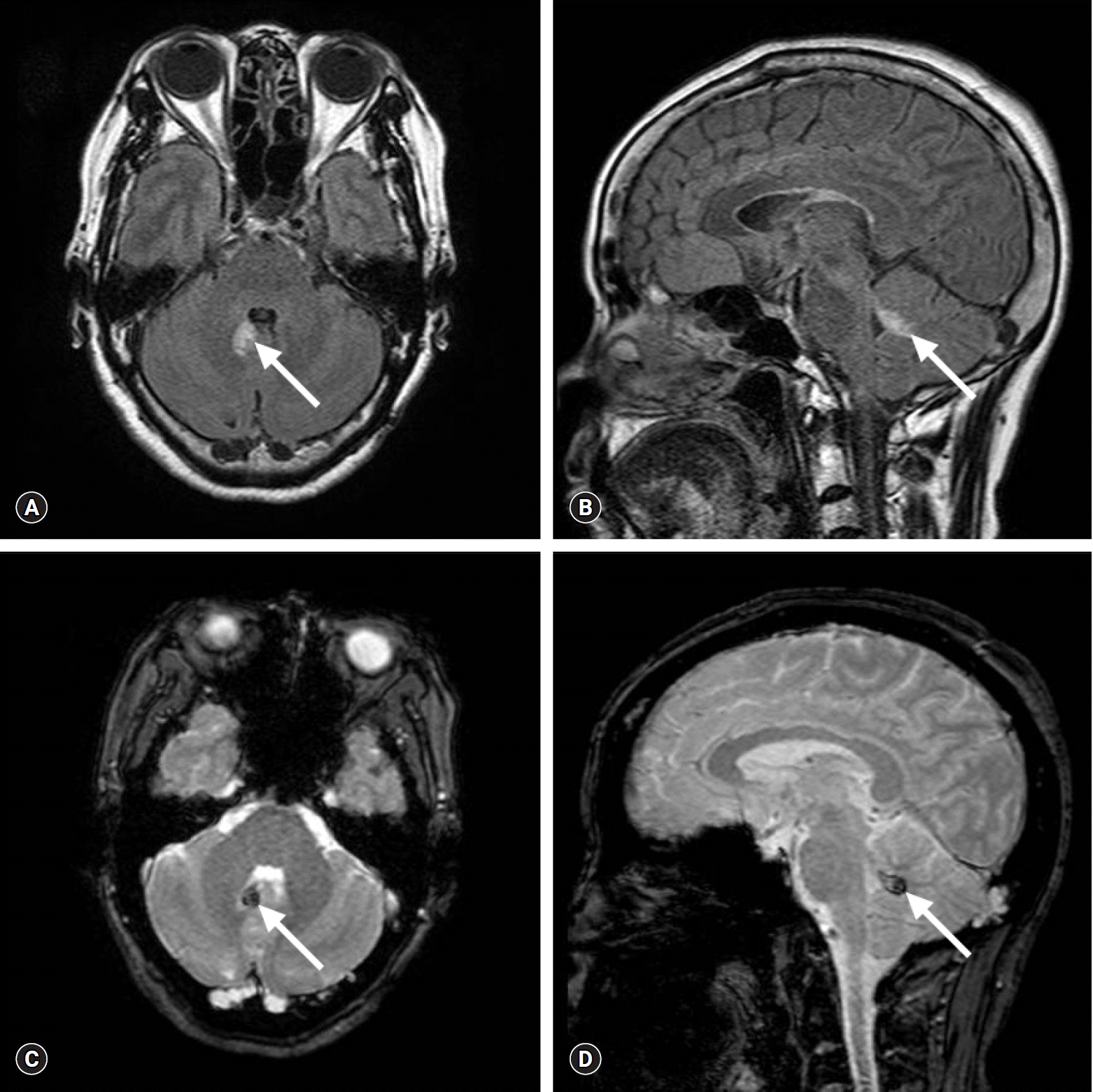Yeungnam Univ J Med.
2019 Sep;36(3):269-272. 10.12701/yujm.2019.00318.
Isolated hemorrhage in the cerebellar vermis with vertigo and body lateropulsion to the contralesional side
- Affiliations
-
- 1Department of Neurology, Yeungnam University of College of Medicine, Daegu, Korea. sejinmayo@ynu.ac.kr
- KMID: 2460198
- DOI: http://doi.org/10.12701/yujm.2019.00318
Abstract
- There have been several reports of patients with isolated lesions of the cerebellar vermis presenting with clinical features similar to those of peripheral vestibulopathy. We report a case of small, isolated hematoma in the cerebellar vermis in a patient who presented with vertigo, ipsilesional nystagmus, and body lateropulsion to the contralesional side without the usual signs or symptoms of cerebellar dysfunction. Although they present with symptoms that mimic those of peripheral vestibulopathy, and brain computed tomography shows no abnormality, as there may be a small, isolated hematoma or infarction in the cerebellar vermis. Thus, brain magnetic resonance imaging should be performed in elderly patients with vascular risk factors.
Keyword
MeSH Terms
Figure
Reference
-
References
1. Kase CS, Mohr JP, Caplan LR. Intracerebral hemorrhage. In : Mohr JP, Choi DW, Grotta JC, Weir B, Wolf PA, editors. Stroke: pathophysiology, diagnosis, and management. 4th ed. Philadelphia: Churchill Livingstone;2004. p. 327–76.2. Kattah JC, Kolsky MP, Luessenhop AJ. Positional vertigo and the cerebellar vermis. Neurology. 1984; 34:527–9.
Article3. Huang CY, Yu YL. Small cerebellar strokes may mimic labyrinthine lesions. J Neurol Neurosurg Psychiatry. 1985; 48:263–5.
Article4. Johkura K. Central paroxysmal positional vertigo: isolated dizziness caused by small cerebellar hemorrhage. Stroke. 2007; 38:e26–7.
Article5. Lee H, Yi HA, Cho YW, Sohn CH, Whitman GT, Ying S, et al. Nodulus infarction mimicking acute peripheral vestibulopathy. Neurology. 2003; 60:1700–2.
Article6. Lee H, Cho YW. A case of isolated nodulus infarction presenting as a vestibular neuritis. J Neurol Sci. 2004; 221:117–9.
Article7. Lee H. Isolated body lateropulsion caused by a lesion of the rostral vermis. J Neurol Sci. 2006; 249:172–4.
Article8. Oh YM, Choi KD, Oh SY, Kim JS. Periodic alternating nystagmus with circumscribed nodular lesion. Neurology. 2006; 67:399.
Article9. Muley SA, Bushara KO. Isolated gait ataxia due to cerebellar vermis infarct. Arch Neurol. 2004; 61:1461.
Article10. Shan DE, Wang V, Chen JT. Isolated lateropulsion of the trunk in cerebellar infarct. Clin Neurol Neurosurg. 1995; 97:195–8.
Article11. Bertholon P, Michel D, Convers P, Antoine JC, Barral FG. Isolated body lateropulsion caused by a lesion of the cerebellar peduncles. J Neurol Neurosurg Psychiatry. 1996; 60:356–7.
Article12. Lee H, Sohn CH. Axial lateropulsion as a sole manifestation of lateral medullary infarction: a clinical variant related to rostral-dorsolateral lesion. Neurol Res. 2002; 24:773–4.
Article13. Kim SH, Cho J, Cho JH, Han SW, Kim SM, Park SC, et al. Isolated lateropulsion by a lesion of the dorsal spinocerebellar tract. Cerebrovasc Dis. 2004; 18:344–5.
Article14. Thömke F, Marx JJ, Iannetti GD, Cruccu G, Fitzek S, Urban PP, et al. A topodiagnostic investigation on body lateropulsion in medullary infarcts. Neurology. 2005; 64:716–8.
Article15. Norrving B, Magnusson M, Holtås S. Isolated acute vertigo in the elderly; vestibular or vascular disease? Acta Neurol Scand. 1995; 91:43–8.
Article
- Full Text Links
- Actions
-
Cited
- CITED
-
- Close
- Share
- Similar articles
-
- Isolated nodular infarction and vestibular neuritis
- Isolated Body Lateropulsion as a Presenting Symptom of Lateral Medullary Infarction
- Isolated Infarction of Anterior Cerebellar Vermis
- Body Lateropulsion as an Isolated or Predominant Symptom of a Pontine Infarction
- A Clinical Study on Cerebellar Vascular Accident



